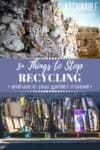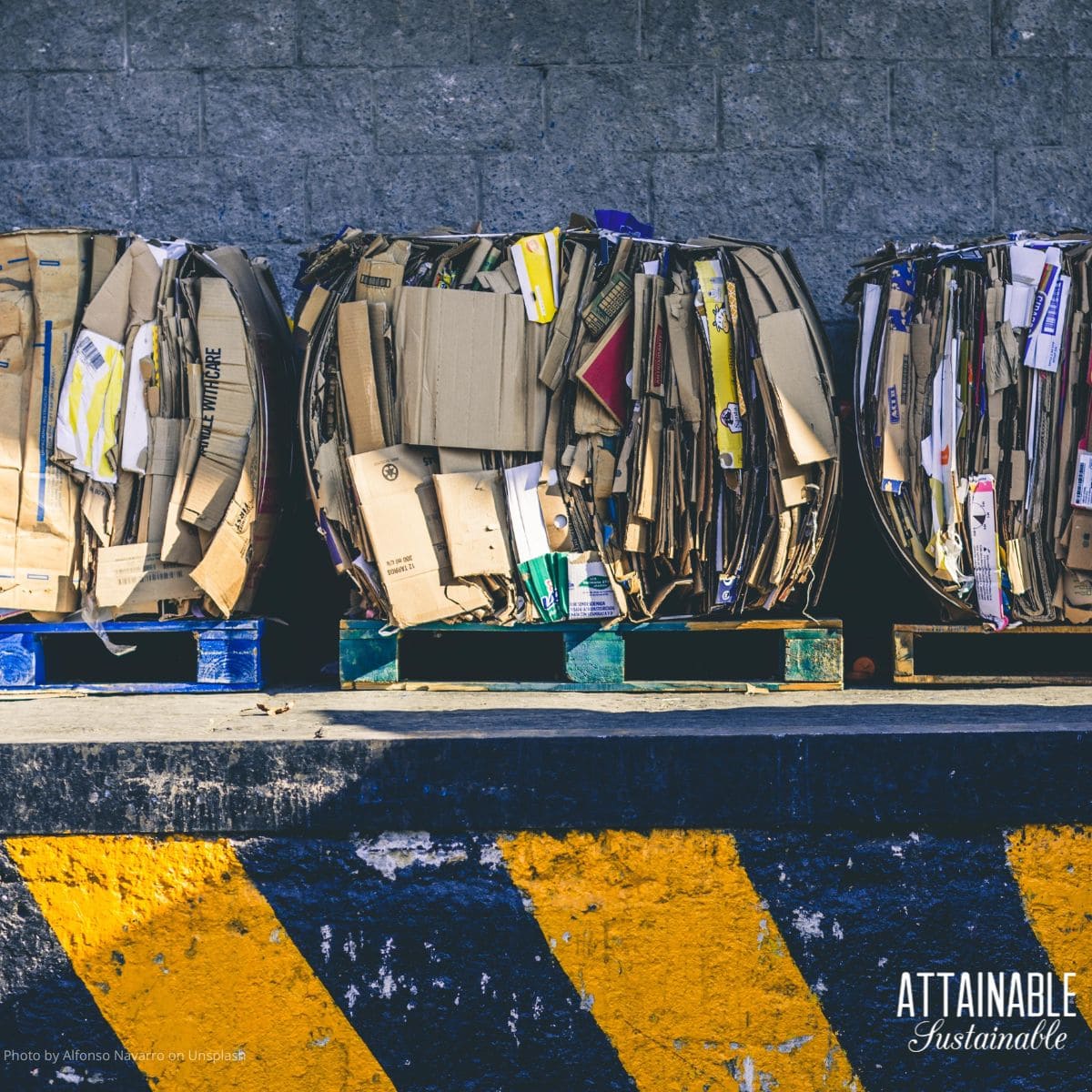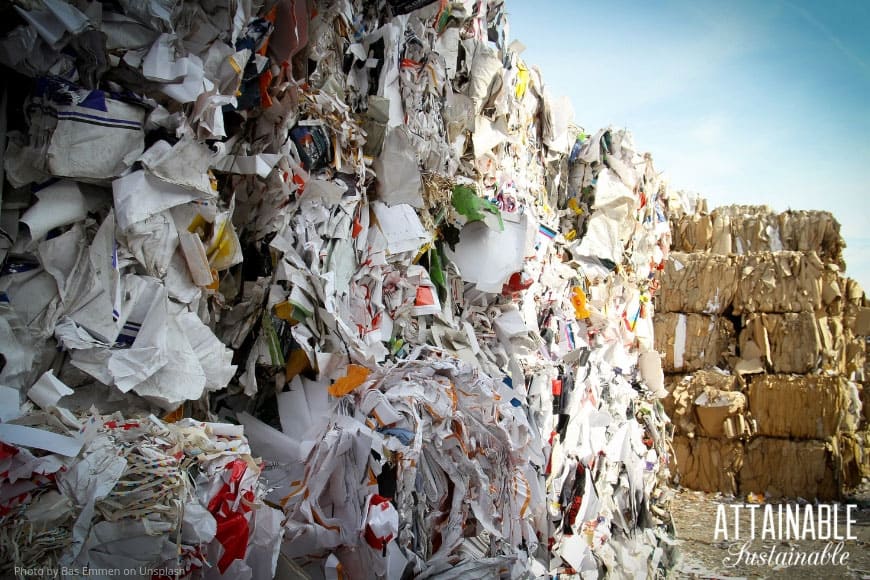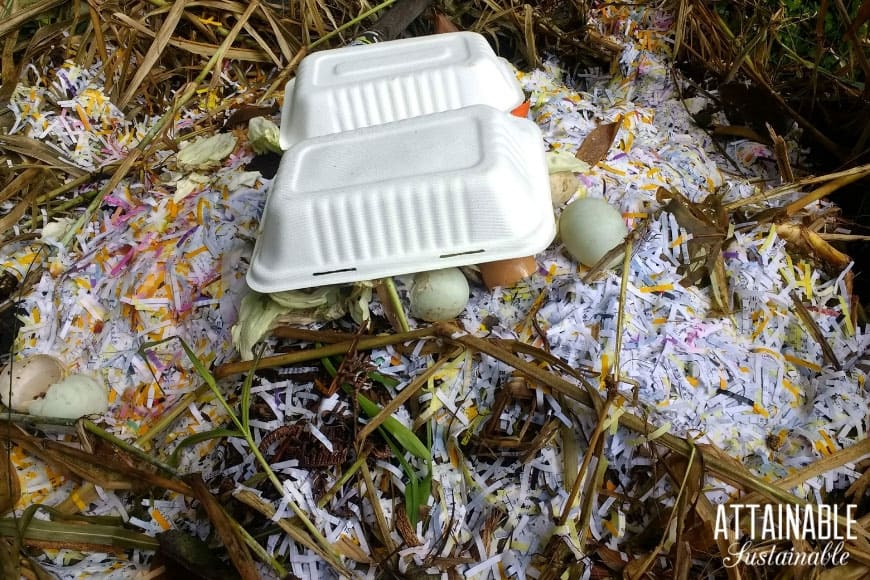The idea of commercially recycling our household waste was been ingrained in us over the last few decades. But what if I told you that you should stop taking some things to the recycle center? That’s right. I recommend that you stop recycling cardboard, paper, and magazines. Here’s why.
Originally published February 2019; this post has been updated.
Rethinking Recycling
Those big bales of cardboard that you see behind stores? Or at the landfill? They’re going to be shipped off to a recycling center to be reprocessed. Or at least that used to be the way it used to be done. For years, China has imported much of America’s recycling, but they’re drastically cutting the amount of waste that they’ll take. This is leaving American cities with piles of recyclable waste…that’s not recyclable.
But as cities scramble to figure out how to deal with this blow, gardeners can help the situation by diverting some of that waste. Instead of recycling cardboard, turn it into an asset in the garden. Same with recycling paper and magazines.
Of course we should all be working to reduce the amount of trash we generate. Be greener. But many of these waste products that do make it to your household can all become part of your composting system, transforming waste into a valuable soil amendment. This alleviates the backup of recycling cardboard and other waste we humans generate.
Cardboard in the Garden
A corrugated cardboard box may be a waste product for many people, but they’re a coveted item here. We stopped recycling cardboard eons ago.
Take a Peek Inside My Book!
Get a free excerpt from my book, Attainable Sustainable: The Lost Art of Self-Reliant Living! You’ll also get my free weekly newsletter, complete with recipes, gardening tips, and a little peek at what’s going on around here — both the zany and the mundane.
I use cardboard as one of my first defenses in keeping weeds down. Shipping boxes that arrive here are immediately stripped of tape and flattened to use as natural weed control.
Using the lasagna method of creating a garden bed calls for laying large pieces of flat cardboard on the ground and layering organic materials like fresh grass clippings and compost on top.
Cardboard can also be added to the compost heap. You can hasten the decomposition process of composting cardboard by tearing it into smaller pieces. Shredded cardboard in the compost is considered one of the brown materials and should be balanced with green materials in the compost bin. Read more about browns and greens and the entire composting process here.
Besides recycling cardboard boxes used for shipping, consider these other cardboard waste items:
- Pizza boxes
- The display boxes Costco sends your items home in
- Case boxes from large purchases
Avoid adding shiny cardboard or obviously plastic coated cardboard to the garden; you’ll end up with lots of little pieces of thin plastic left behind.
Stop Recycling Paper
Paper is one of the easiest items to shift out of the recycling loop. Newspaper, office paper, and junk mail are all good carbon additions to a compost pile. These break up relatively quickly.
I sort my junk mail, separating out the plastic windows on envelopes (those go to the trash) and composting the rest. (See more below about dealing with glossy paper.) More paper items to divert:
- Shredded office paper
- Paper flour bags
- Brown paper bags
- Paper plates, napkins, and paper towels (though you’re probably not still using those, right?)
- Paper bakery wraps from bread and pastries
Related: Why I don’t recommend recycling plastic
Composting Paperboard
Paperboard is kind of a hybrid between heavier cardboard and paper, most recognizable as cereal boxes and cracker boxes.
Some paperboard packaging is “pulpier” than others. Flat paperboard can be utilized as weed barrier or added to the compost. Bulkier paperboard can go right into the compost. These are all compostable:
- Egg cartons
- Cartons from rolled oats
- Toilet paper and paper towel tubes
- Cotton swabs (Q-tip brand is made with paperboard rather than plastic)
- Paperboard to-go containers
Stop Recycling Magazines
Whether magazines or catalogs, this is the trickiest category. Glossy paper comes with its own possible risks due to the ink used. While newspapers are primarily printed with soy-based ink these days, magazines and catalogs (and some junk mail) have different coatings.
There is some concern in the gardening world about using these items in the compost. Our preference with magazines is to share them with other readers via our library. We still find ourselves inundated with catalogs and other glossy paper, though.
Worms to the rescue! A vermicompost bin is a good solution for this problem. Worms have been found useful in bioremediation of toxins like lead and cadmium. I’ve added shredded glossy paper to my worm bin for years, with no detrimental impact on the worms.
Now, I’ve not had the worm castings tested. And obviously, this is not a 100% organic solution. But handling this waste here, on site, rather than shipping it off for someone else to deal with is my preference.
Does this Work?
Some may question the nutritive value of a compost pile made up of a lot of paper and cardboard. As I see it, a compost pile that gobbles up our trash has a certain value.
If you’re concerned that the compost made with these items is less valuable for your garden, use it for other things around the yard. Fill low areas, create berms, give it away. Or do as Angi mentioned in the comments and utilize this compost around sunflowers, which according to this article may help removed contamination from soil.
I consider creating potentially low quality compost a grand improvement over bales of cardboard and paper sitting at a recycling facility.









It helped when you mentioned that recycling can help you save the environment. My uncle mentioned to me last night that he and his friend are hoping to find commercial recycling solutions for their company and asked if I have any idea what is the best option to consider. Thanks to this informative article and I’ll be sure to tell him that it will be much better if they consult a trusted commercial recycling solutions company as they can answer all their inquiries and will provide their needs.
You’re welcome, glad it helped!
For a long time, I have thrown soft paper (paper towels, napkins, teabags, tissues, etc.) into the compost bucket. It breaks down quickly, so does corrugated cardboard if it is torn up. I even compost the full vacuum cleaner bags which are mainly dirt, pet hair, dust, and spilled food particles. I just rip the bag open and throw it on the compost pile. It also breaks down fairly quickly. I sometime add in shredded office paper that others throw away. It all becomes soil, after awhile.
I don’t compost office paper because of the plastics in the inks used. Has this changed?
Many printers have shifted to soy based inks. I don’t use plastic coated cardboard, but everything else.
The cardboard/paper doesn’t have to be nutricious – it’s carbon – that’s the sponge for the nutriens. Just like humus is not nutricious – it’s the stuff it “holds on to”, that is. 🙂
Use https://www.catalogchoice.org/ to cut down on the glossy paper coming into your house.
This is such a great article! I, too, recycle these things in my garden, I completely agree that creating low quality compost is better than littering the world with our paper products.
I try to keep the the things that have more ink around non-edibles like sunflowers since they help with soil clean up. https://news.virginia.edu/content/uva-undergraduate-researcher-studies-sunflowers-power-clean-soil
Interesting! Thanks for that, Angi!
I would be wary of the inks used to make the cereal boxes and have not read that it is environmentally safe, have you?